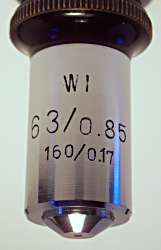 Objective Markings: What they mean.
Objective Markings: What they mean.
 This objective is a low power planachromat by the Czech company Meopta. It is engraved with all the information a microscopist needs for a fairly good idea of the quality of image it would produce.
This objective is a low power planachromat by the Czech company Meopta. It is engraved with all the information a microscopist needs for a fairly good idea of the quality of image it would produce.
Starting at the top: the figure 170 is the optical tubelength of the Meopta microscope it was designed to be fitted to. Meopta, as well as Leitz, adopted a 170mmm tubelength standard, whilst most of the rest of the world went with the Zeiss standard of 160mm.
Next comes a slash and a dash. It is common practice for the tubelength figure to be separated by a slash from the figure representing the coverglass thickness for which the objective is corrected. In this case, the dash indicates that the objective's performance is independent of coverglass thickness -- you may use one or not as you please.
Next line down -- Pl indicates that the objective is a planachromat; ie, an objective of normal achromatic correction, but additionally corrected to eliminate or reduce field curvature, and therefore giving a sharply focused image of flat subjects. The figures 6.3:1 are the objective magnification expressed as a ratio to one.
The final figure, 0.15, is the objective N.A.
By noting the ratio of the objective's magnification to its N.A., the experienced microscopist can predict within fairly narrow limits what the performance of the objective is likely to be.
The tubelength figure is also important, as if it is intended to use the objective on a microscope stand built to the 160mm tubelength standard, all other things being equal, the objective will produce a lower magnification and have a longer working distance than if used on a Meopta (170mm) microscope.
 This is a high-power water immersion objective of Chinese manufacture and another completely specified objective.
This is a high-power water immersion objective of Chinese manufacture and another completely specified objective.
WI of course indicates the important fact that the objective is designed to work with its frontlens immersed in water. The next line of figures are the magnification and the N.A. separated by a slash, and the bottom figures are the tubelength and coverglass correction -- much as in the Meopta objective above. The figure 0.17 is the thickness in millimetres of the coverglass for which the objective is corrected. This thickness is now standard and designated No. 1½ by most coverglass manufacturers.
In terms of predicting performance, the following considerations. The figure of 0.85 for the N.A. indicates a higher resolving power than a 40 power objective with an N.A. of 0.65. The magnification of x63, however, indicates that the image will appear less sharp than the x40, because the increase in magnification has not been matched by a corresponding increase in the N.A.
If this objective were to be used on a microscope built to the 170mm tubelength standard, the magnification would be slightly more than the engraved value, the image would show a degree of spherical over-correction, and its working distance would be less than if used on the microscope for which it was designed. There are ways of compensating these departures from specification, but they are outside the scope of the present discussion.
In the absence of any other markings, it can be correctly assumed that the objective is not flatfield, and is a normal achromat.
There are other things that the microscopist must know about an objective to obtain the best possible image from it, particularly in the choice of a suitable eyepiece, but they can be known only either by by hands-on experimentation, or by familiarity with the optical practices of the company which produced it. This latter information is often only obtainable by direct contact with the technical department of the company in question.